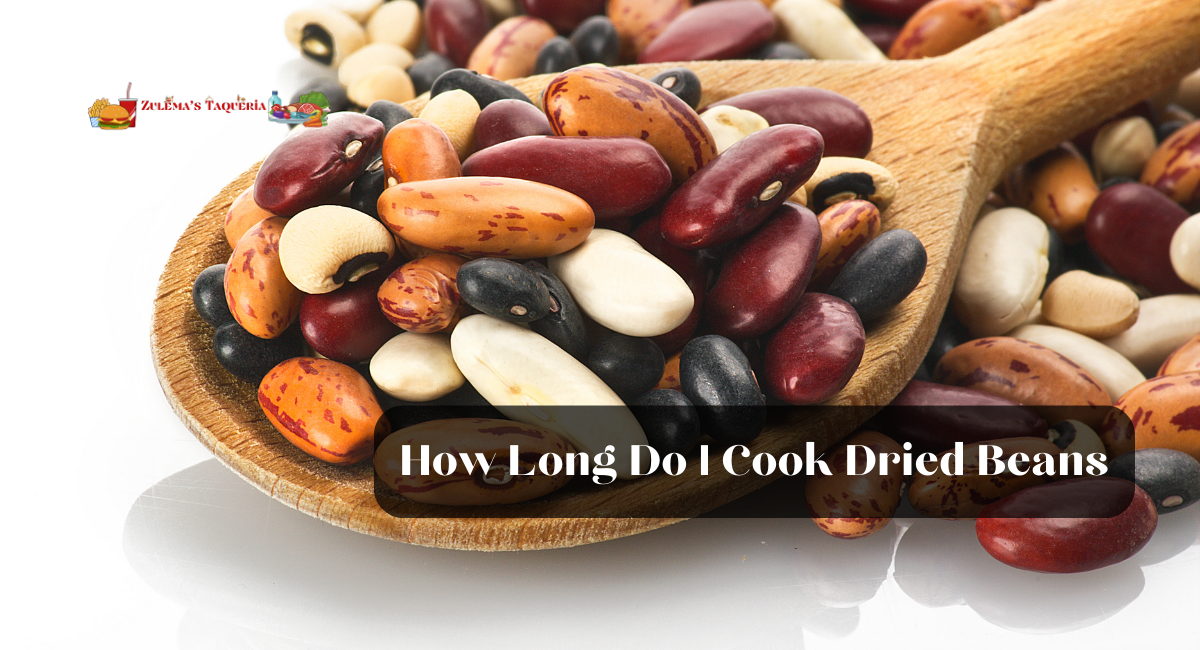Cooking dried legumes is a versatile and economical way to add flavor and nutrition to various dishes. Whether preparing a hearty bean broth, a flavorful bean salad, or a savory bean stew, it is essential to know how long to cook dried beans to achieve the ideal texture and flavor. This article will explain how long do we cook dried beans.
How Old Are Your Beans?
If you have ever spent hours cooking beans only to find they are still too firm to eat, the problem is likely not the recipe or your cooking method, but the bean itself. If you’ve cooked these legumes and reached this unfortunate conclusion, your best option is to dispose of them.
Most dry beans should be eaten within two years of being picked. It’s not always easy to figure out when a crop was picked, but most bags of dried beans sold in grocery stores have a “best by” date on them. Check it before you buy it, or if you already have a bag in your pantry, check it before you cook it.
How Long Do I Cook Dried Beans
Since cooking time depends on the maturity of the beans and whether they have been soaked, it is impossible to provide precise cook times for beans, but in general:
45 to 90 minutes for small legumes (black beans, black-eyed peas, and navy beans).
60 to 120 minutes for medium beans (Great Northern, kidney, pinto, garbanzo).
80 to 180 minutes for large beans (large Lima, Cannellini, and butter beans).
Option 1. Overnight Soak Your Beans
This technique is for you because
- Soaking cuts down on preparation time
- Produces a bean that is plumper and cooks uniformly
- Reduces the harmful effects of legumes on your digestive system
How to proceed:
- Place the legumes in a basin.
- Wet the surface with water. The basin must be covered with a lid or plastic wrap.
- Allow to sit on the countertop overnight.
- Drain, sanitize, prepare, and consume.
Option 2. Soak Your Beans Rapidly
This method is for you because
- Like the overnight marinating method, this reduces the cooking time, which is ideal when braising beans, such as in this Cowboy Beans recipe.
How to proceed:
- Put beans and peas in the pot.
- Put water on the top.
- They must come to a boil, which is the covering.
- Take the beans off the heat and let them soak for up to an hour in warm water, depending on the bean.
- Keep following the recipe.
Option 3. Avoid Soaking Your Beans
This method is for you because
- Soaking requires planning, which is different from your thing.
- You desire velvety legumes: When legumes are soaked, they release starch into the soaking water, which can diminish the creaminess of the final product.
- You prefer bold color: You want black beans to be black and red beans to be crimson. Without soaking, more pigment remains on the bean and is not leached away by the water.
How to proceed:
- Place legumes in the pot
- Wet the surface with water
- Cook and Eat
How Do I Cook Dried Beans
Ingredients
Soaking up
- 1 cup of legumes, including chickpeas, white beans, black beans, pinto beans, and Gigante beans.
- 4 to 6 glasses of water
- 2 tablespoons of coarse salt
Aromatic
- 12 large yellow onion, skinned and cut into large wedges
- 3 trimmed cloves of garlic
- 3-4 rosemary, thyme, and oregano stems
- 1 buchu leaf
- 2 teaspoons of olive oil
- 1 gram of sea salt
Instruction
- Place the beans in a strainer and sift through them to remove debris. Rinse the legumes thoroughly.
- Transfer the beans to a jar, submerge them with water, and add salt. Soak overnight or up to twenty-four hours.
- Drain the beans and place them in a cooking pot when preparing to cook.
- Add enough water to cover the legumes by about 2 inches. Add salt and aromatics. Bring to a simmer, and after 15 minutes, torandul.
- Reduce the heat to low at 15 minutes so the beans are just below a simmer.
- Cook the beans until soft, sampling periodically to determine the proper texture.
- If desirable, add more salt to the dish.
- This is also the time to incorporate any acidic ingredients.
After cooking
- Allow the vessel to cool for about twenty minutes before removing any aromatics.
- Transfer to a receptacle to cool further. Once the beans have chilled, they should be sealed and stored in the refrigerator.
- Use within seven days.
Doneness
When the beans are done, they will be tender and readily mashed between your fingers. Cooking times can vary depending on variables such as the age of the beans and your location’s altitude, so it’s best to begin testing for doneness around the minimum cooking time and adjust as necessary.
Seasoning
Beans can be seasoned with salt and other seasonings during or after simmering. However, adding salt too early in the cooking process can cause the beans to become rigid, so it is typically advised to add salt after cooking.
Tips
- Sort and rinse: Before soaking or cooking the dried beans, spread them on a clean surface and remove any damaged or discolored beans, stones, or residue. Then, thoroughly rinse the legumes under cold water.
- Soaking: While soaking is optional for certain legumes, such as lentils and split peas, it can significantly reduce cooking time and improve the digestibility of others. For optimal results, marinate overnight and plan.
- Use Sufficient Water: When cooking beans, ensure sufficient water to submerge them by approximately 2 inches. As the beans cook, they will absorb moisture; therefore, examine them periodically and add additional liquid if necessary to prevent them from drying out.
- Cooking Methods: Consider using a pressure cooker (e.g., an Instant Pot) to reduce cooking time substantially. Beans can be cooked under pressure in a fraction of the time it takes on the cooktop.
- Experiment: Feel free to experiment with various bean types and seasonings to create multiple dishes. Beans can be used in salads, casseroles, and sauces, among other dishes.
Thanks for reading.










